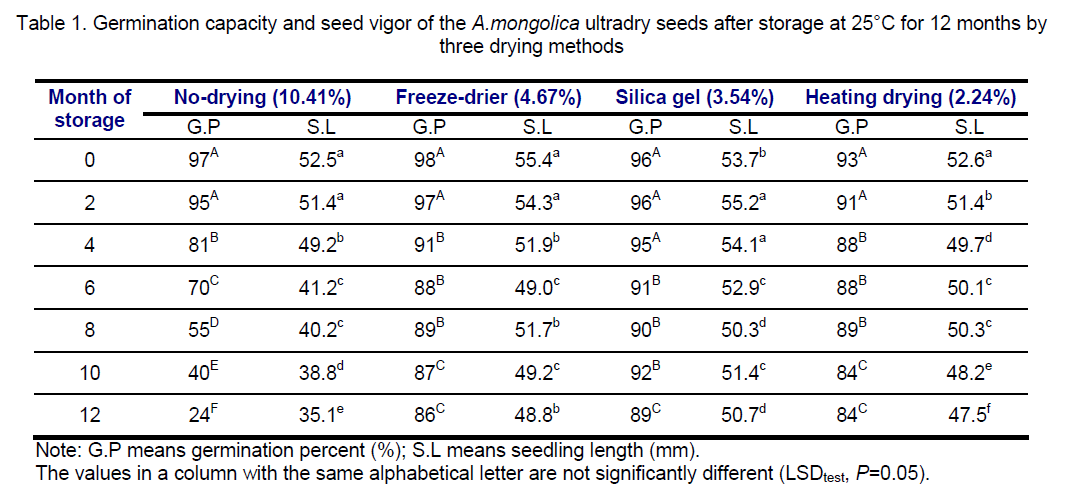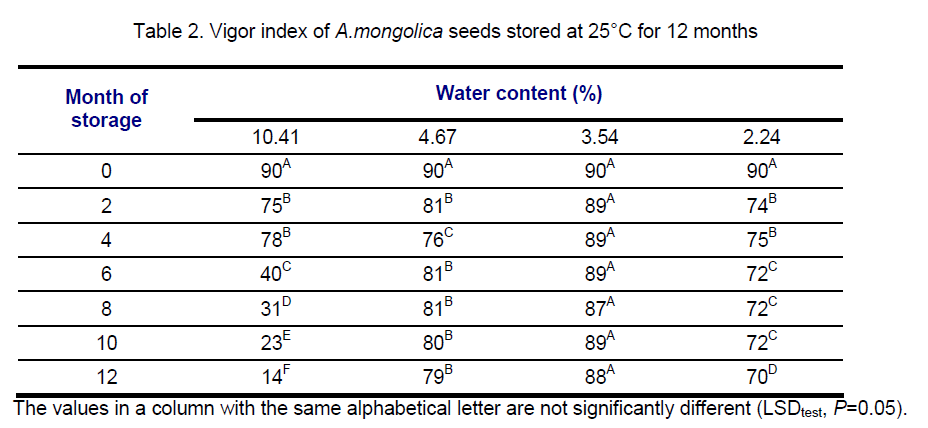The Effect of Different Ultradry Methods and Seed Water Content on Viability of Ammopiptanthus mongolicus Seeds
Yi Li, Lizhe An
Yi Li,Lizhe An*
School of Life Sciences,Lanzhou University,Lanzhou,730000,China
Abstract
This research aimed to determine whether ultradry storage improves the longevity of Ammopiptanthus mongolicus seeds. Water content of A.mongolicus seeds was dried to 2.24%-4.67% (dry weight) and stored at 25°C for 12 months. Three different drying strategies were used: (1) drying over silica gel at 25°C; (2) in a freeze-drier at -20°C and (3) in an oven at 50°C. After 12 months of storage, the seeds of original water content (10.41%) lost total viability. The ultradry seeds obtained by storage over silica gel, freeze-drying and heating maintained high germination capacity. The results indicate that the three methods can be used safely to ultradry the A.mongolicus seeds. Viability of the ultradry seeds was not affected by the drying temperatures employed in this study. Water content of seed was a key index for storage at ambient temperature and 3.54% seem to be the best water content for ultradry seeds in our research. From these results, we conclude that seed water content less than 5% enhances longevity and ultradry could be an economical way for conservation of the plant genetic resource.
Keywords
ultradry,water content,seed storage,Ammopiptanthus mongolicus.
1. Introduction
Today we are faced with an urgent challenge to organize the efficient conservation of biodiversity. For plants we do this by storing their seeds in a gene bank and the preferred temperature of -15 ÃÆâÃâââ¬Å¾ÃâÃâis recommended by International Board for Plant Genetic Resources (IBPGR). However,the cost of cold storage is beyond the means for many developing countries. A project to develop a new technology for plant germplasm conservation partially instead of cold storage is an important work of the FAO and IPGRI in this developmental strategy [1]. Research about ultradry storage have been a focus in the filed of seed science and plant conservation biology since the end of the 1980s. The idea of ultradry,it means reduced the seed water content less than 5% and stored seeds at atmospheric temperature [2-4]. This technology can greatly reduce the cost of constructing and maintaining the gene bank. It has potential economic effect and promising application in germplasm conservation. A lot of important progress and positive results of ultradry storage have been reported [5-11]. But the potential adverse of ultradry to seed longevity must be weighed because of the potential risk of damaging seeds by extreme drying. It has been recognized that drying seeds to very low water contents may reduce longevity. Thus an optimum water content for storage may exist,and the value is likely to be dependent on different species [12]. It is also possible that the method of drying affects seed longevity. Many studies that used silica gel to dry seeds to low water contents showed no evidence of reduced storage life when seeds were dried to very low levels [2-3]. However,onion,pepper and parsley seeds aged faster if freeze dried to water contents less than 4.3% and 5%,respectively [13].
A.mongolicus is dominant plant in stabilized sand field in the northern desert of China. They appear to be suitable for revegetating of desert and have a reputation to high tolerance to water deficit. They have great potential to provide different services such as halting desert encroachment and stabilizing sand dune,there has been little experimental research dealing with the protection germplasm resource. The purpose of this study was to determine whether drying seeds to very low water contents improved seed life spans,to establish the water content at which there was a limit to the beneficial effects of drying,and to evaluate the efficacy of different drying methods.
2. Materials and Methods
Seeds of A.mongolicus were harvested in 2003 at Minqin Desert Plant Botanical Garden (38034’N,102058’E) Gansu province,China. Initial water content of seeds was 10.41% and represented the equilibrium moisture contents for seeds in open storage in the Lanzhou area in the summer (25°C,75% RH). Initial germination percentages were greater than 95%. A range of seed water contents was achieved by drying seeds with different desiccating agents for different periods. Seeds were divided into three aliquots. The first aliquot was freeze dried (TFD-550-5 freeze-drier,Tokara Seisakusho Co. Ltd) for 2 days. Comparable water contents were achieved in the second aliquot by drying seeds in a 50°C oven for 2 days. Water contents were matched in the third aliquot by drying seeds over silica gel (silica gel: seed = 4:1) at normal atmospheric temperature (25°C) for 2 weeks. The silica gel was regenerated daily during drying. Seeds were also dried to a constant weight over silica gel after 4 weeks. By three different drying strategies,the water content reduced to 4.67% (freeze-drier),3.54% (silica gel) and 2.24% (heating drying). After drying period,seeds were packaged in sealed aluminum foil packages and stored at room temperature for next experiment. Water contents were determined gravimetrically and are expressed on a fresh weight basis. Dry weights were measured after seeds were heated to 110±2°C for 10±1 h [14].
Periodically samples of each storage and water content variants and seed viability were evaluated. Data on seed samples viability were recorded after 2,4,6,8,10 and 12 months of storage. Seeds were tested for germination on top of three piece of filter paper moistened with 4 cm3 distilled-deionized water in 6-cm-diameter Petri dishes at 20°C ±1°C. Four replicates of 50 seeds were used for each treatment. Emergence of the radicle was the criterion used to assess germination. Germination was counted for 7 days. Seeds vigor index (Iv) was determined according to the following equation: Iv=GI×Sx,GI=Σ(Gt/Dt),where GI is germination index,Sx is radicle mean length x days after germination and Gt is germination percentage after t days,Dt is days of germination. The results presented are the mean values of three samples. To avoid possible imbibition injury,dried seeds were exposed to 100% RH at room temperature for 3 days.
3. Results and Discussion
Data on the viability of seed samples presented in this paper are concerning the effects of ultradry storage on A.mongolicus seed storability. The results showed that the water content which seeds were dried and the methods of drying were not affected the germination percentage: all seed samples maintained germination percentages close to the initial (no-drying) value (Table 1). After stored 12 months,the germination and vigor index of no-drying seeds greatly decreased from 97% to 24% and from 90 to 14,respectively. But for ultradry seeds only a little decreased,the ranges of drop were G.P 7%-12%,vigor index 2-20,respectively. This suggested that the storability could be improved under ultradry condition. As has been shown previously [2-4],the water content at which seeds were stored had a significant effect on viability. Viability was significantly reduced in control samples (no-drying) stored at 25°C after 12 months (Table 1 and Table 2). Results showed clearly the advantageous effect of ultradry storage on the longevity of A.mongolicus samples after 12 months of storage. The experiment also reveled that in the case of ultradry storage,that the seed water content did influence seed viability during storage. Our research found the A.mongolicus seed was sensitive to ultradry,when seed with 2.24% of water content,the germination percent and vigor index tended to decrease. So,the optimized water content is important for A.mongolicus seed storage. Storability of seeds with 3.54% water content was the best. Reductions in viability occurred in 3.54% water content samples stored at 25°C for 12 months,but to a lesser extent than the other samples. Within optimum moisture ranges,there appeared to be no relationship between drying method and seed viability after 12 months of storage. Differences in germination rates among treatments appeared to be more a result of experimental variation than a consistent effect of drying. For example,maximum germination in seeds was observed in the freeze-dried samples. Reduced longevity was also observed in seeds dried to very low water contents (2.24%) by heating drying.


4. Conclusion
The results from these experiments demonstrate that seeds stored at 25°C must be dried to prolong self life. There are several ways that seeds can be dried,and there appears to be no particular difference in longevity when seeds are dried by either exposure to silica gel,freeze drying or heating to 50°C,as long as the seeds are not over-dried.
Acknowledgements
We are grateful to Prof. Zhang Yong for providing experimental materials. Financial support for this study was provided by National Natural Science Foundation of China (90302010).
References
- Zheng G.H.,Jing X.M. (1998) Ultradry seed storage cuts cost of gene bank. Nature,393: 223-224.
- Ellis R.H.,Hong T.D.,Roberts E.H. (1989) A comparison of the low moisture content limit to the longarithmic relation between seed moisture and longevity in twelve species. Annals of Botany,63: 601-611.
- Ellis R.H.,Hong T.D.,Roberts E.H.,et al. (1990) Low moisture content limits to relations between seed longevity and moisture. Annals of Botany,65: 493-504.
- Zheng G.H. (1994) Ultradry Seed Storage: possible improved strategies and technology for germplasm conservation. Chinese Biodiversity,2: 61-65.
- Ellis R.H.,Hong T.D.,Roberts E.H. (1992) The low-moisture-content limit to the negative logarithmic relation between seed longevity and moisture content in three subspecies of rice. Annals of Botany,69: 53-58.
- Ellis R.H.,Hong T.D.,Martin M.C.,et al. (1993) The long term storage of seeds seventeen crucifers at very low moisture contenrs. Plant Varieties and Seeds,6: 75-81.
- Ellis R.H.,Hong T.D.,Astley D.,et al. (1994) Medium-term storage of dry and ultra-dry seeds of onion at ambient and sub-zero temperatures. Onion Newsletter for the Tropics,6: 56-58.
- Ellis R.H.,Hong T.D.,Roberts E.H. (1995) Survival and vigor of lettuce (Lactuca sativa L.) and sunflower (Helianthus annuus L.) seeds stored at low and very-low moisture contents. Annals of Botany,76: 521-534.
- Zheng G.H. (2004) Ultradry seed storage: improved strategy and technology for germplasm conservation. In: Zheng G H,(Eds). Seed Physiology Research. Science Press,Beijing,pp. 131-136.
- Cheng H.Y.,Song S.Q.,Zhu C.,et al. (2005) Cytological,physiological and biochemical basis of storability of ultradry seeds. Acta Botanica Yunnanica,27(1): 11-18.
- Cheng H.Y. (2005) Research background and progress of seed ultradry storage technology. Acta Botanica Yunnanica,27(2): 340-124.
- Wilson D.,Mcdonald M. (1986) A convenient volatile aldehydes assay for measuring soybean seed vigor. Seed Sci and Tech,1(4): 256-258.
- Woodstock L.W.,Maxon S.,Paul K.,et al. (1983). Use of freeze-drying and acetone impregnation with natural and synthetic antioxidants to improve storability of onion,pepper and parsley seeds. Journal of the American Society for Horticultural Science,108: 692-696.
- ISTA (1993) International rules of seed testing. Rules and annexes. Seed Sci and Tech,21: 1-287.

Open Access Journals
- Aquaculture & Veterinary Science
- Chemistry & Chemical Sciences
- Clinical Sciences
- Engineering
- General Science
- Genetics & Molecular Biology
- Health Care & Nursing
- Immunology & Microbiology
- Materials Science
- Mathematics & Physics
- Medical Sciences
- Neurology & Psychiatry
- Oncology & Cancer Science
- Pharmaceutical Sciences
